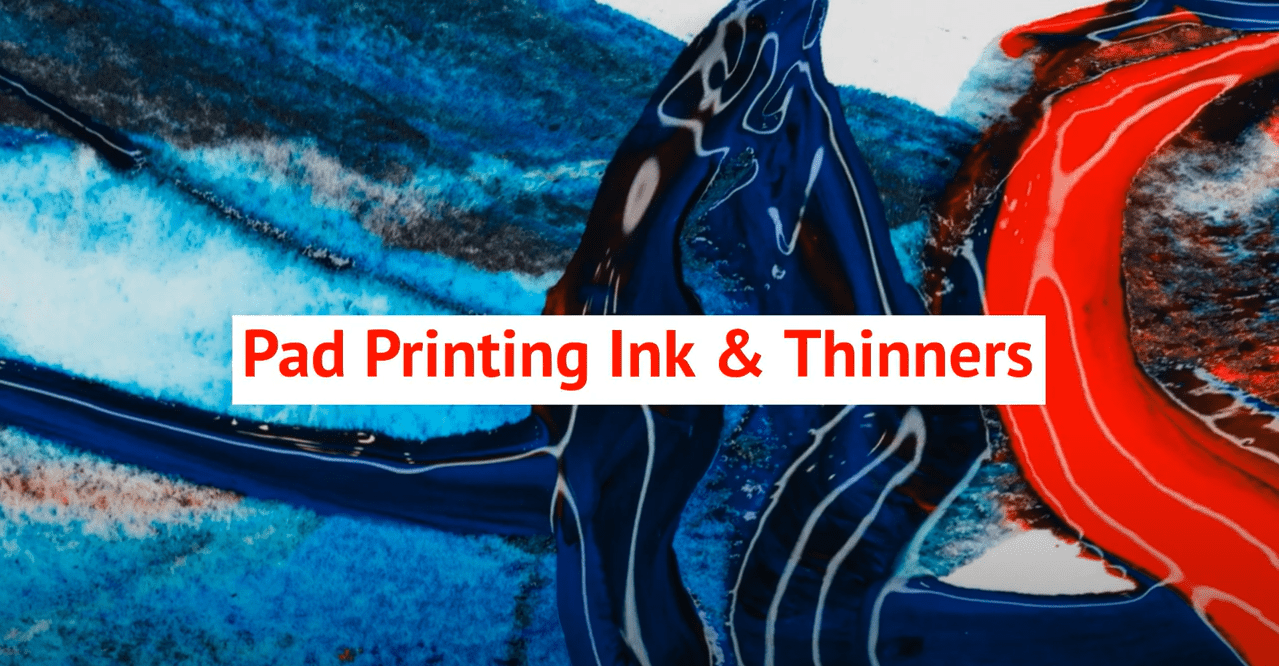Offering the Highest Quality Inks
Here at Teca-Print USA, we pride ourselves on being able to offer you a complete solution to your pad printing needs. We have access to four of the world’s largest ink manufacturers. If your substrate is pad printable, we have an ink to print it. In addition to standard pad printing inks, Teca-Print USA has full-color matching capabilities. Virtually any color you want, we can match exactly.
Ink Use Information
The Pad Printing Process
Ink becomes tacky as a result of evaporation in the cliché before ink pick-up and then on the pad. Below is a highlight of the pad printing process:
Pretreatment of Polyolefins
Material pretreatment achieves an optimum ink adhesion on polyolefin, polyethylene (PE), and Polypropylene (PP). The minimum surface tension requirement is 38 Dyn = 0.038 N / m and can be tested using the test pen. A lesser surface tension requires more intense pretreatment.
Post-treatment of Polyoxides
After the print, materials must be exposed to thermal shock to obtain a chemical reaction of the ink with the material surface. Additionally, the thermal shock should be approximately 350°C.
Curing Time
Two to six days is the ideal chemical curing time for 2-component inks. The result is optimum adhesion, abrasion resistance, and chemical resistance.
Chemical Resistance
Chemical resistance in 1-component inks is never as high as the chemical resistance of 2-component inks. These are mostly utilized on materials easily etched by the mixed ink.
Abrasion Resistance
Utilize 2-component inks when high-abrasion resistance is required.
The Viscosity Process
With 2-component inks, ink and hardener must be mixed thoroughly before adding thinners. Failure to do so leaves behind concentrated hardener lumps, causing the ink’s partial curing.
The desired viscosity can be attained by adding thinner in relatively small amounts and stirring. Adding thinner in larger quantities washes the ink pigments out of the resin.
Use of Retarders
Ink viscosity should be strictly modified using thinners. In case of external environmental influences, retarders can be added in controlled amounts.
Pot Life
2-component ink systems result in a chemical reaction. High room temperatures and high relative air humidity reduce pot life.
Mixing Systems and Ink Ranges
Mixing systems come in a wide variety for all pad printing ink ranges.
Ink Ranges
Every ink type is available strictly in NT pigmentations and conforms to EN 71, part 3, the safety of toys, and migration of certain elements. Additionally, HD = extra opaque inks.
1-Component Inks
TPC 118 is an opaque silk gloss pad printing ink used to print soft and hard plastic materials and metals. It has superb fluidity and can be applied in open and closed machine systems.
1/2 Component Inks
TPC 180 is the most universal and opaque pad printing ink ideal for thermoplastic materials. It has excellent opacity and a glossy finish.
TPC 301 is a printing ink free from cyclohexanone and aromatic compounds. It has a glossy finish and weatherproof properties.
TPC 320 is a glossy, stable pad printing ink perfect for thermoplastic materials. It is very user-friendly, weather-resistant, alcohol-resistant, and petrol-resistant.
TPC 528 is an silk gloss pad printing ink with impressive fluidity, quick drying abilities, and is highly opaque and can be applied for closed and open machine systems.
2-Component Inks
TPC 508 is an opaque silk gloss pad printing ink with impressive fluidity and can be applied for closed and open machine systems.
TPC 200 is a resistant, glossy pad printing ink used in technical industries and graphic fields. Its properties include quick drying, impressive adhesion, good opacity, and a glossy finish.
TPC 230 is a pad printing ink with maximum resistance, quick drying abilities, and a glossy finish. It also has high resistance to organic solvents, chemicals, acids, and thinned alkalis.
TPC 250 is a glossy pad printing ink for bottle and glass printing. Upon mixing with HI, HG, and HH hardeners, a perfect adhesion is obtained with air drying or curing, depending on the hardener used.
How to Use the Viscospatula
- Stir the ink to ensure thorough pigment mixing.
- Place the Teca-Print mixing cup in the cup holder.
- Pour the required ink amount into a mixing cup.
- Add thinner drop by drop and stir.
- Dip the VISCOSPATULA into the cup so that the top hole in the VISCOSPATULA is immersed in ink.
- Lift the VISCOSPATULA vertically out of the ink.
- As the ink flows down the VISCOSPATULA, notice how the holes open up from top to bottom. The amount of time it takes to flow from the first small hole to the bottom indicates the ink’s viscosity. Measure the flow time with a wristwatch. Experience indicates that a time of about 8 seconds is advisable, although this can vary slightly depending on ink type, color, and particular ink usage.
Extra Tips
If the flow time is too fast, the ink is too thin. Adding unthinned ink thickens it up. If the flow time is prolonged, add thinner in small quantities while stirring. If the ink acts thixotropically, the VISCOSPATULA isn’t reasonably applicable. Fortunately, an 8-10% addition can adjust such ink tones.
Ink and Additive Ordering Information
Inks
Our extensive range of inks is supplied in 1 l or 1 KG cans. Most inks are on stock, amd inks that are not on stock have a delivery time of about four weeks.
Additives
Hardener is available in 100 ml tubes and 1 l cans. All special additives and solvents are supplied in 1 l cans, and some are also available in 5 l cans.
Your Partner for Pad Printing Inks and Thinners
At the forefront of innovation in the pad printing industry, Teca-Print is an expert at custom in-house ink mixing. We can match virtually any color you need. Having been in the industry for over 30 years, we are a trusted source for high-quality pad printing.
We always strive to meet your needs. Contact us to learn more or request a quote.

